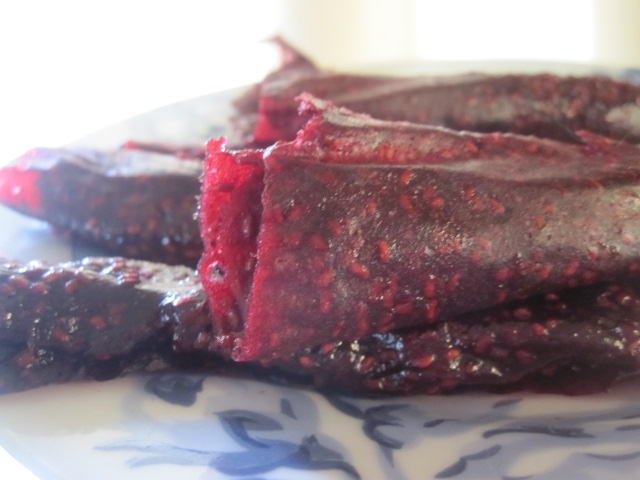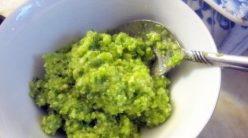Not only is fruit leather all natural, but it costs very little (or nothing, if it’s from berries in your back yard!) and it’s a great way to use up fruits that are past their prime. Kids can have also a great time mixing and matching fruits.

Easy Fruit Leather
Ingredients:
- 2 cups fresh fruit (cleaned, pitted, peeled, etc.)
- 2-3 TBS honey (raw and local, if possible) or agave, dandelion syrup or sweetener of choice
- Several drops of lemon juice (optional)
Instructions:
- Puree your fruit in a blender until well processed. If you like, you can remove the seeds from fruits like blackberries by pressing the puree through a sieve with a spoon or running it through a food mill. We usually leave our seeds and like the crunch and extra fiber.
- Stir in your honey and lemon juice. You can adjust the measurements to suit the sweetness of your fruit.
- Line your sheet pan with parchment paper and pour the puree in to about an 1/8 inch thickness.
- Dry according to preference (see options below). The fruit leather is ready when it is just slightly sticky to the touch.
- Cut it and roll it up. You can also simply cut it into rectangles to serve. Store it in the refrigerator (a glass jar would be perfect) if you’re not planning on eating it within the day. Ours doesn’t last that long!
Options for drying your fruit leather include:
- Cook it in an oven at 200 degrees for approximately 2-4 hours. I find that our fruit leather needs quite a bit of time. In light of this, I tend to use more energy efficient means of drying it.
- Set the oven to 140, put the fruit leather in, turn off the heat and leave it for several hours or overnight. Check your fruit leather and turn the oven back on briefly and continue until dried.
- Use a food dehydrator.
- Use the “hot car method.” Put the fruit leather in the back window of a south facing car on a sunny day. It should take about an afternoon.
- Dry your leather outside. Simply cover with a window screen or cheesecloth (tented) and leave in a sunny location where it will be undisturbed.
- Dry it outside in a solar cooker or even under a garden cold frame (a glass cover meant to protect plants from frost).
- If you have other ideas, please leave them in the comments!
What fruits work well in fruit leather?
Lots of foraged fruits are especially nice in fruit leather, especially when mixed and matched. Naturally sour fruits can be combined with sweeter fruits to bring the best of both out. Mulberries make fantastic fruit leather (be sure to add a touch of lemon juice or a handful of more sour fruits). Don’t use elderberries unless you cook them first, as elderberries should not be eaten raw. Likewise, apples work better when used as sauce and can be combined with more tart fruits or fruits that you don’t have much of.
Some of our favorite fruits for fruit leather (especially in combinations) include:
- Mulberries
- Raspberries
- Black raspberries
- Wild plums (remove the peels by dropping in boiling water for a few seconds and peeling if they are overly acrid)
- Peaches
- Gooseberries
- Strawberries
- Blueberries
Other fruits work better to simply dry. Apples and mangoes are examples of fruits that are great simply sliced and dried.
What are your favorite fruits for fruit leather?






2 thoughts on “Easy DIY Fruit Leather”
Wonderful Ways to Use Mulberries - A Magical Life
(June 29, 2018 - 12:47 am)[…] them in fruit leather. Mulberries work well in our easy DIY fruit leather, either alone or (or favorite) combined with other […]
Ten Fun Ways We've Learned and Played Lately | Magic and Mayhem
(July 23, 2018 - 12:35 am)[…] We made fruit leather with blackberries and raspberries from our back yard and strawberries that we’d frozen from […]